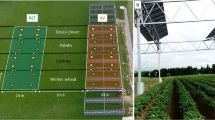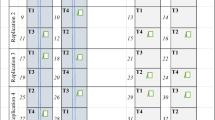Abstract
Water consumption of table grapevines (Vitis vinifera cv. Superior Seedless) trained to a large open-canopy gable system was measured during six growing seasons (1999, 2001–2005) using 12 drainage lysimeters. The lysimeters (1.3 m3 each) were installed as part of a one-hectare vineyard in a semi-arid region in southern Israel. Water consumption of the lysimeter-grown vines (ETc) was used as the basis for the calculation of irrigation applications in the vineyard. Three irrigation treatments, 80% (high), 60% (medium) and 40% (low) of ETc of the lysimeter-grown vines, were applied in the vineyard. Reference evapotranspiration (ETo) was calculated from regional meteorological data according to the Penman–Monteith equation. Seasonal curves for the crop coefficient (K c) were calculated as K c = ETc/ETo. Maximum ETc values in different seasons ranged from 7.26 to 8.59 mm day−1 and seasonal ETc (from DOY 91 through DOY 304) ranged from 1,087 to 1,348 mm over the six growing seasons. Leaf area index (LAI) was measured monthly using the SunScan Canopy Analysis System. Maximum LAI ranged from 4.2 to 6.2 m2 m−2 for the 2002–2005 seasons. A second-order polynomial curve relating K c to LAI (R2 = 0.907, P < 0.0001) is proposed as the basis for efficient irrigation management. The effects of the irrigation treatments on canopy growth and yield are presented. The high ETc and K c values that were observed are explained by the wide canopy layout that characterize the large open-gable trellis system.





Similar content being viewed by others
References
Allègre M, Daire X, Héloir MC, Trouvelot S, Mercier L, Adrian M, Pugin A (2007) Stomatal deregulation in Plasmopara viticola-infected grapevine leaves. New Phytol 173:832–840
Allen RA, Pereira LS, Raes D, Smith M (1998) Crop evapotranspiration: guidelines for computing crop water requirements. (FAO Irrigation and Drainage Paper 56) FAO, Rome
Ayars JE, Hutmacher RB (1994) Crop coefficients for irrigating cotton in the presence of ground water. Irrig Sci 15:42–52. doi:10.1007/BF00187794
Ayars JE, Johnson RS, Phene CJ, Trout TJ, Clark D, Mead RM (2003) Water use by drip-irrigated late-season peaches. Irrig Sci 22:187–194. doi:10.1007/s00271-003-0084-4
Behboudian MH, Singh Z (2001) Water relations and irrigation scheduling in grapevine. Hortic Rev 27:189–225
Braun P, Schmid J (1999) Sap flow measurements in grapevines (Vitis vinifera L.): 1. Stem morphology and use of the heat balance method. Plant Soil 215:39–45. doi:10.1023/A:100475600 2983
Bravdo B, Hepner Y (1987) Water management and effect on fruit quality on grapevines. In: Lee T (ed) Proceedings of the 6th Australian wine industry technical conference, Adelaide, July 14–17, 1987. Australian Industrial Publications, Adelaide, pp 150–158
Chalmers DJ, Andrews PK, Harris KM, Cameron EA, Caspari HW (1992) Performance of drainage lysimeters for evaluation of water use by Asian pears. HortScience 27:263–265
Cifre J, Bota J, Escalona JM, Medrano H, Flexas J (2005) Physiological tools for irrigation scheduling in grapevine (Vitis vinifera L.): an open gate to improve water-use efficiency? Ecosyst Environ 106:159–170
Cohen S, Rao RS, Cohen Y (1997) Canopy transmittance inversion using a line quantum probe for a row crop. Agric For Meteorol 86:225–334. doi:10.1016/S0168-1923(96)02426-4
Dokoozlian NK, Hirschfelt DJ (1995) The influence of cluster thinning at various stages of fruit development on ‘Flame Seedless’ table grapes. Am J Enol Vitic 46:429–436
Doorenbos J, Pruitt WO (1977) Crop water requirements. (FAO Irrigation and Drainage Paper 24) FAO, Rome
Eastham J, Gray SA (1998) A preliminary evaluation of the suitability of sap flow sensors for use in scheduling vineyard irrigation. Am J Enol Vitic 49:171–176
Erie LJ, French OF, Bucks DA, Harris K (1982) Consumptive use of water by major crops in the southwestern United States (Conservation Research Report no. 29). United States Department of Agriculture, Washington, D.C
Evans RG, Spayd SE, Wample RL, Kroeger MW, Mahan MO (1993) Water use of Vitis vinifera grapes in Washington. Agric Water Manage 23:109–124. doi:10.1016/0378-3774(93)90035-9
Ferreyra R, Selles G, Silva H, Ahumada R, Munoz I, Munoz V (2006) Effect of applied water on water relations and productivity of ‘Crimson Seedless’ table grapes. Pesqui Agropecu Bras 41:1109–1118
Fuchs M (2007) Impact of research on water use for irrigation in Israel. Irrig Sci 25:443–445. doi:10.1007/s00271-006-0050-z
Ginestar C, Eastham E, Gray S, Iland P (1998) Use of sap-flow sensors to schedule vineyard irrigation. I. Effects of post-veraison water deficits on water relations, vine growth, and yield of ‘Shiraz’ grapevines. Am J Enol Vitic 49:413–420
Grantz DA, Williams LE (1993) An empirical protocol for indirect measurement of leaf area index in grape Vitis vinifera L. Hortscience 28:777–779
Grimes DW, Williams LE (1990) Irrigation effects on plant water relations and productivity of ‘Thompson Seedless’ grapevines. Crop Sci 30:255–260
Hamman RA, Dami IE (2000) Effects of irrigation on winegrape growth and fruit quality. Horttechnology 10:162–168
Jagtap SS, Jones JW (1989) Stability of crop coefficients under different climate and irrigation management practices. Irrig Sci 10:231–244
Jonckheere I, Fleck S, Nackerts K, Muys B, Coppin P, Weiss M, Baret F (2004) Review of methods for in situ leaf area index determination. Part I: theories, sensors and hemispherical photography. Agric For Meteorol 121:19–35
Liu CM, Zhang XY, Zhang Y (2002) Determination of daily evaporation and evapotranspiration of winter wheat and maize by large-scale weighing lysimeter and micro-lysimeter. Agric For Meteorol 111:109–120. doi:10.1016/S0168-1923(02)00015-1
Lobel DB, Field CB, Cahill KN, Bonfils C (2006) Impacts of future climate change on California perennial crop yields: Model projections with climate and crop uncertainties. Agric For Meteorol 141:208–218. doi:10.1016/j.agrformet.2006.10.006
Matthews MA, Anderson MM (1989) Reproductive development in grape (Vitis vinifera L.): responses to seasonal water deficits. Am J Enol Vitic 40:52–60
Matthews MA, Anderson MM, Schultz HR (1987) Phenologic and growth responses to early and late season water deficitsin ‘Cabernet Franc’. Vitis 26:147–160
Netzer Y, Yao C, Shenker M, Cohen S, Bravdo B, Schwartz A (2005) Water consumption of ‘Superior Seedless’ grapevines grown in a semiarid region. Acta Hortic (ISHS) 689:399–406
Oliver HR, Sene KJ (1992) Energy and water balances of developing vines. Agric For Meteorol 61:167–185
Peacock WL, Christensen LP, Andris HL (1987) Development of a drip irrigation schedule for average-canopy vineyards in the San Joaquin Valley. Am J Enol Vitic 38:113–119
Prior LD, Grieve AM (1987) Water used and irrigation requirements of grapevines. In: Lee T (ed) Proceedings of the 6th Australian wine industry technical conference, Adelaide, July 14–17, 1987. Australian Industrial Publications, Adelaide, pp 165–168
Rollin H, Meriaux S, Boubals D (1981) Sur l’irrigation de la vigne dans le midi de la France. Prog Agric Vitic 98:447–459
Salon JL, Chirivella C, Castel JR (2005) Response of cv. Bobal to timing of deficit irrigation in Requena, Spain: water relations, yield, and wine quality. Am J Enol Vitic 56:1–8
Sammis TW, Mapel CL, Lugg DG, Lansford RR, McGuckin JT (1985) Evapotranspiration crop coefficients predicted using growing degree days. Trans ASAE 28:773–780
Shani U, Ben-Gal A (2005) Long-term response of grapevines to salinity: osmotic effects and ion toxicity. Am J Enol Vitic 56(2):148–154
Shellie KC (2006) Vine and berry response of ‘Merlot’ (Vitis vinifera L.) to differential water stress. Am J Enol Vitic 57:514–518
Slack DC, Martin EC, Sheta AE, Fox FJ, Clark LJ, Ashley RO (1996) Crop coefficients normalized for climate variability with growing-degree days. In: Proceedings of the international conference on evapotranspiration and irrigation scheduling. American Society of Agricultural Engineers, pp 892–898
Smart RE, Coombe BJ (1983) Water relations of grapevines. In: Kozlowski TT (ed) Water deficits and plant growth. Academic Press, New York, pp 137–196
Snyder R, Pruitt W (1985) Estimating reference evapotranspiration with hourly data. In: Snyder R et al. (eds) California Irrigation Management Information System Final Report. Univ. of California-Davis, Ch. 7
Stevens RM, Harvey G (1996) Soil water depletion rates under large grapevines. Aust J Grape Wine Res 2:155–162
Tarara JM, Ferguson JC (2001) Device for simulating high rates of sap flow in grapevines. Am J Enol Vitic 52:260–265
Trambouze W, Bertuzzi P, Voltz M (1998) Comparison of methods for estimating actual evapotranspiration in a row-cropped vineyard. Agric For Meteorol 19:193–208
Valenzuela-Ruiz MJ, Contreras FR, Grijalva-Contreras RL, Duarte RM (2005) Effect of ‘Harmony’ and ‘Freedom’ rootstocks on yield and quality of `Red Globe’ table grapes. HortScience 40:993–1147
van Rooyen FC, Weber HW, Levin I (1980) The response of grapes to a manipulation of the soil–plant–atmosphere continuum. II: plant–water relationships. Agrochemophysica 12:69–74
van Zyl JL, van Huyssteen L (1980) Comparative studies on wine grapes on different trellising systems: I. Consumptive water use. S Afr J Enol Vitic 1:7–14
Wilhelm WW, Ruwe K, Schlemmer MR (2000) Comparison of three leaf area index meters in a corn canopy. Crop Sci 40:1179–1183
Williams LE (1998) Water use of ‘Thompson Seedless’ grapevines measured with weighing lysimeters during a late season dry down period. Proceedings of the 1st ISHS workshop on water relations of grapevines. Acta Hortic 493:161–167
Williams LS, Ayars JE (2005a) Water use of Thompson Seedless grapevines as affected by the application of gibberellic acid (GA3) and trunk girdling—practices to increase berry size. Agric For Meteorol 129:85–94
Williams LS, Ayars JE (2005b) Grapevine water use and crop coefficient are linear functions of the shaded area measured beneath the canopy. Agric For Meteorol 132:201–211
Williams LE, Phene CJ, Grimes DW, Trout TJ (2003a) Water use of young ‘Thompson Seedless’ grapevines in California. Irrig Sci 22:1–9. doi:10.1007/s00271-003-0066-6
Williams LE, Phene CJ, Grimes DW, Trout TJ (2003b) Water use of mature ‘Thompson Seedless’ grapevines in California. Irrig Sci 22:11–18. doi:10.1007/s00271-003-0067-5
Yang SL, Aydin M, Yano T, Li X (2003) Evapotranspiration of orange trees in greenhouse lysimeters. Irrig Sci 21:145–149. doi:10.1007/s00271-002-0062-2
Yunusa IAM, Walker RR, Blackmore DH (1997a) Characterisation of water use by ‘Sultana’ grapevines (Vitis vinifera L.) on their own roots or on ‘Ramsey’ rootstock drip-irrigated with water of different salinities. Irrig Sci 17:77–86. doi:10.1007/s00271-0050025
Yunusa IAM, Walker RR, Guy JR (1997b) Partitioning of seasonal evapotranspiration from a commercial furrow-irrigated ‘Sultana’ vineyard. Irrig Sci 18:45–54. doi:10.1007/s002710050043
Yunusa IAM, Walker RR, Loveys BR, Blackmore DH (2000) Determination of transpiration in irrigated grapevines: Comparison of the heat-pulse technique with gravimetric and micrometeorological methods. Irrig Sci 20:1–8. doi:10.1007/PL00006714
Acknowledgments
The authors would like to thank Mr. Amram Hazan for his assistance and for offering his agronomic expertise and Y. Cohen for operating the lysimeters. This study was supported by Israeli Ministry of Agriculture Project No. 826-047-05, by the Israeli table grape growers association and by the Eugene and Edith Schoenberger foundation.
Author information
Authors and Affiliations
Corresponding author
Additional information
Communicated by E. Fereres.
Rights and permissions
About this article
Cite this article
Netzer, Y., Yao, C., Shenker, M. et al. Water use and the development of seasonal crop coefficients for Superior Seedless grapevines trained to an open-gable trellis system. Irrig Sci 27, 109–120 (2009). https://doi.org/10.1007/s00271-008-0124-1
Received:
Accepted:
Published:
Issue Date:
DOI: https://doi.org/10.1007/s00271-008-0124-1




